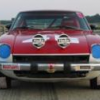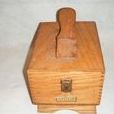Well I've never held an early tach with my own two hands, so this is mostly engineering speculation, but I would go something like this...
The early tachs ran the coil current to the tach. And (now that I've seen that picture), I would surmise that they used an inductive pickup for the tach to sense the ignition pulses. Just like the inductive pickup on your timing light. It senses current that flows through a wire, and just like your timing light, it does that by wrapping a "sensor" around the wire your interested in. Also the same as your clamp-on ammeter you use for house wiring to measure the current being drawn by your beer fridge.
So that thing on the back of the tach is the inductive pickup, and the white wire running through it is the one being sensed.
So now the real guessing starts... I'm guessing that the inductive pickup on the back of the tach is relatively cheap and prone to crosstalk and/or wave shape. I'm thinking that there may have been some crosstalk from the portion of the wire NOT looped through the sensor that was messing with the sensing of the wire that WAS looped trough the pickup. So by moving the loop of wire farther away from the pickup, it reduced the crosstalk or changed the wave shape just enough that the tach likes is better.
Kinda hard to do that kind of analysis with no parts like that here though. Could be totally off, but until someone has something better......









